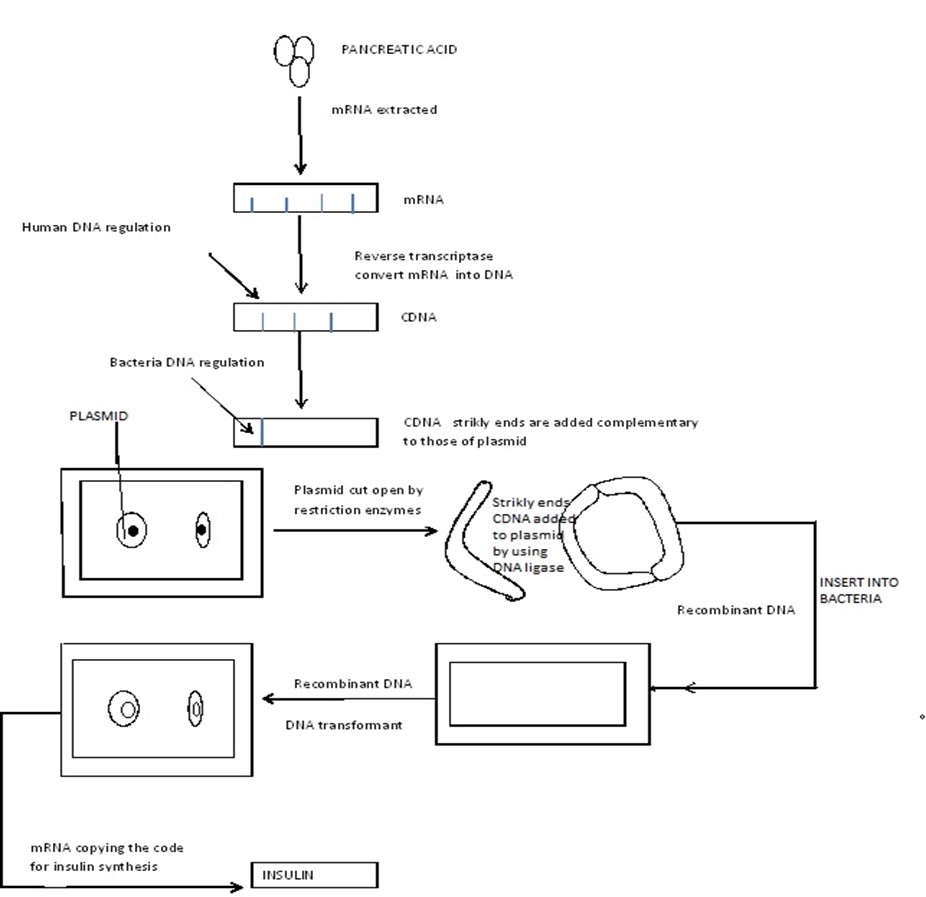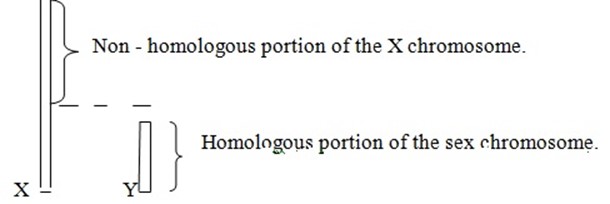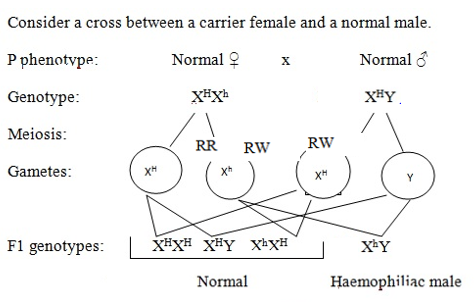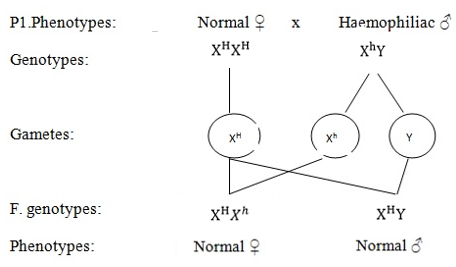GENETIC ENGINEERING (Recombinant DNA technology)
Definition: Genetic engineering or recombinant DNA technology is defined as the manipulation of DNA of one organism (donor) and its transfer into another organism (the host) where its combines with that of the host organism.
Where it combines with that of the host organism
- To create as new gene combination, genetic engineers must be able to
edu.uptymez.com
- Located a specific gene in the donor cell.
- Modify the donor DNA in a highly selective way.
- Isolate the located gene.
-
Transfer the modified DNA into the host cell in such away the gene will be expressed strongly enough to be practical use.
Techniques used to manipulate DNA
edu.uptymez.com
- The manipulation of DNA involves three techniques each of which uses specific enzyme or group of enzymes.
-
The molecules to modify DNA (the enzyme used) are;
1. Reverse transcriptase
-
This catalyses the synthesis of DNA from RNA.
2. Restriction endonucleases
-
These are used to cut DNA at specific sections.
3. DNA Ligase
- This joins the donor and vector DNA section so as to form a recombinant DNA molecule.
- The techniques of recombinant DNA technology are:-
edu.uptymez.com
- Splitting the DNA molecule into smaller portions using restriction endonuclear which are specific to particular base sequences on the DNA.
-
Copying the required DNA section using the enzyme reverse transcriptase which controls the synthesis of DNA from the RNA. The resulting DNA is called copy or complementary DNA
(cDNA).
- Adding the gene the vector DNA.
- Formation of recombinant DNA molecule with vector.
-
Joining the DNA portions together using DNA ligase enzyme.

Illustration: Consider the diagram below showing the synthesis of insulin
Question
Define the terms:-
-
(b) Gene cloning.
(c) Transgenic organism.
SOLN
- A clone is a group of cells of similar characteristics that are able to replicate and produce more cells.
- Gene cloning is a process whereby multiple copies of a given gene are produced which may then be used to manufacture larger quantities of valuable products.
-
A transgenic organism is a genetically modified organism (GMO) ie: the organism formed as a result of genetic engineering. New genes are added into embryo of an organism.
MERITS AND DEMERITS OF GENETIC ENGINEERING
- Merits of genetic engineering
- Synthesis of hormones such as insulin, growth hormones etc.
- Production of vaccine and antibiotics. Already interferon has been synthesized by genetic engineering.
- Increases plant resistance to pests eg: cotton and potatoes.
- Improves quality and quantity of animal products such as milk.
- It offers endless opportunities to manipulate DNA.
- Demerits
- The materials contained in the manipulated DNA, are likely to undergo mutation.
- The use of genetic engineering in the manufacture of biological weapons is a mis-application of genetics.
- The use of GMO’s for human consumption is dangerous as it increases cancer chances.
-
Some practices of Genetic engineering may not be in line with ethical and moral values.
Phenlyketonuria (PKU)
edu.uptymez.com
- PKU is a recessive autosomal condition.
- The disease is due to inability to convert the amino acid phenylalanine to another amino acid, tyrosine.
edu.uptymez.com
Phenylalanine
Hydrolase.
Phenylalanine (PAH) Tyrosine.
The enzyme PAH is normally there in the liver.
As a result of phenylalanine builds up in the body and the excess is converted into toxins which affect mental development.
Affected children appear normal at birth because, while in their mother’s uterus during pregnancy, excess phenylalanine moves across the placenta and is removed by the mother’s liver. If not treated soon, harmful effects are noted.
Identifying PKU in new born babies
- Few days later after birth, blood test is carried on and higher level than normal of phenylalanine is detected.
edu.uptymez.com
Qn:Why the baby not tested when is first born?
Answer
Its excess phenlylalanine is removed by the mother while it is in the uterus. It takes a few days for the levels of phenylalanine to build up.
Genetic screening and parental diagnosis:
Genetic screening is the detection of mutant genes in an individual.
There are three situations where genetic screening is of particular relevance namely;-
- Prenatal diagnosis.
- Carrier diagnosis.
-
Predictive diagnosis.
Prenatal diagnosis
This is the use of modern medical techniques to identify any health problems of the unborn baby.
It includes the detection of genetic disease. If such a disease is detected, it is usually possible to provide counseling about the quality of life the child can expect and other potential problems. The parents are usually also given the option to abort.
Carrier diagnosis:
This is the identification of people who carry a particular genetic disease, usually with no visible symptoms or harm to themselves.
Predictive diagnosis:
This is the prediction of a future disease which you are likely to suffer as a result of your genes but not yet produced any symptoms.
Chorionic villus sampling (CVS)
edu.uptymez.com
- A small sample of chorion is withdrawn for examination.
- The cells of the chorion are derived from the zygote, so are genetically identical to the embryo. The chromosomes are examined (Karyotype analysis) and the sex of the child can also be seen.
- The rise of miscarriage is higher than Amniocentesis.
edu.uptymez.com
Amniocentesis
- This involves analysis of amniotic fluid.
- Amniotic fluid is genetically identical to chorion and zygote.
edu.uptymez.com
Mixed concepts
Successfulness of Mendel in his experiment was due to the following reasons.
-
He chose pea plants (P. sativum) in his crossing. Why?
Reasons:
edu.uptymez.com
- P. sativum has short life span.
- P. sativum has many contrasting characters (about 32 contrasting characteristics).
- A plant is Bisexual.
edu.uptymez.com
- He was Imaginative in ratio determination and careful, he covered the stigma with muslin cloth which allowed respiration but prevented pollens of one plant from reaching another plant.
- He did his experiments in a large scale to avoid (eliminate) the effects of mutation.
-
He was intelligent as he used mathematical concepts in explaining the ratio of the results he got.
Modern Mendelian laws (1st Law & 2nd Law)
- The characteristics of an organism occur in pairs of chromosomes which divide during meiosis such that only one of each chromosome appears in gametes.
-
Alleles occur in pairs, they divide by meiosis and during fertilization, zygote is formed from random fertilization in which any of the allele from each pair may combine with the other.
Application of Genetic engineering
- Medicine
- The gene in man that codes for insulin is transferred in the bacterium, Escheriachia coli to produce pure insulin in large quantities.
- Human growth hormone, somatotrophic hormone can be extracted from the pituitary glands of dead bodies.
- Blood clothing factors such as fibrinogen needed by haemophiliacs are produced.
- Vaccines are produced from viruses.
-
Biological Warfare
Micro – organisms that cause diseases have been used in wars.
The micro organisms are cloned and thrown into the territory of the enzyme.
Infections of this bacteria (micro-organism) causes death within few days.
(c) Agriculture
- Research is being done to produce plants that are capable of fixing nitrogen without relying on nitrogen fixing bacteria.
- Genetically modified organisms are used to break down wastes from homes and industries.
- Frozen embryos may be separated into cells, which can be made to grow into new embryos if implanted into the uterus.
- Some plants such as pyrethrum are being propagated through tissue culture.
- Genetic disorders
- Pregnant woman can be told whether the fetus had deformities or not and hence prepare for its birth or terminate it.
- Normal genes can be introduced into the embryos to curb or cure genetic disorder such as sickle – cell anemia.
-
Genetic engineers are designing to produce human like creatures as sources of human spare parts in surgeries and transplants.
Examples of monohybrid inheritance:
- Rhesus factor – In which an organism is either positive or negative.
-
Albinism – If dominant for skin pigmentation (AA or Aa), then an individual is normal though in the later case, he/she is a carrier.
But if recessive homozygous, then an individual is albino.
-
In maize seeds – The seeds are either dominant white or recessive.
How genetic engineering is done
A section of DNA, extracted from an organism or synthesized artificially, is usually translocated to a bacterium or virus. The bacterium or virus used in genetic engineering is called transgenics. Inside the bacterial cell is a structure called plasmid.
The plasmid is split open by some enzymes called restriction endonucleases so as to allow the foreign DNA to enter.
A given restriction enzyme cuts the bacterial plasmid open at specific sites where is determined by the sequence of base in that region. This same enzyme cuts foreign DNA wherever an identical base sequence occurs.
This procedure of splitting open the bacterial plasmid and inserting the foreign DNA is called gene splicing.
The foreign DNA and the plasmid join up, and so the foreign DNA gets incorporated into the plasmid. The enzyme DNA ligase is responsible for joining the foreign DNA and plasmid. The result of the combination is called recombinant DNA.
The foreign DNA replicates along with the rest of the plasmid every time the bacterial cell divides.
The bacterium is selected because it replicates quickly and the offsprings resemble parents.
Once the bacterium has taken up a piece of foreign DNA successfully, it may divide repeatedly into a population of bacterial cell all of which contain replicas the foreign DNA.
This production of large quantities of identical genes by means of genetic engineering is called gene cloning. This technology is currently being used in production of human insulin to save diabetes.
Application of Genetics
-
Plant and animal breeding
It has been observed that crossing two genetically dissimilar organisms of the same species produces organisms that possess beneficial characteristics not shown by either of the parents.
The individual that results from crossing two individuals with contrasting characters is called a hybrid. In cattle, milk production, quick maturation and beef production can be obtained through hybridization.
For example: The Hereford, English breed shows high beef production and quick maturation.
The Boran from Tanzania shows disease resistance and grows on dry pasture.
A cross between the Herefore bull and a Boran cow produces a hybrid of all these qualities.
-
Blood transfusion
Blood transfusion is the transfer of blood from one person, the donor, into the stream of another person, the recipient.
Before blood transfusion, blood is tested to determine the blood group and Rhesus factor. If the blood of the donor is not compatible with the blood of the recipient, agglutination occurs.
The ABO blood group system and the Rhesus antigens are used to settle parentage disputes.
-
Genetic counseling
Genetic information is used to advise couple who have hereditary disorders about the chances of children inheriting the disorders.
Genetic information could also be used in choosing marriage partners.
Symptoms of Down’s syndrome:
edu.uptymez.com
- Mental retardation.
- Straight hair.
- Increased risk of infections particularly respiratory and ear infections.
- Short stature.
-
Heart defects.
PLEIOTROPY
Pleiotropic genes are genes that code for a specific mutabollic process and at the same time affecting other metabolic processes.
eg. In cystic fibrosis, A gene that codes for secretion of Cl– also induce secretion of viscous (thick) mucus in the lungs, pancreases and gut.
QNS
edu.uptymez.com
- (a) Define the term sex limited traits giving one example of a disorder that expresses it.
- Define the term sex influenced characters giving one example of a disorder that expresses it.
- Describe the following disorders showing clearly its mode of inheritance;
- Tuner’s syndrome.
- Klinifelter’s syndrome.
- (a) Explain the following ratios using genetic crosses;
- 9:3:4 cross (2) gives answer.
- 9:7
- 9:3:3:1 under non Mendelian trend of inheritance.
- 3:3:2
- 2:1
-
1:2:1 under non Mendelian trend of inheritance cross (3).
(b) Outline;
(i) How a peptide bond is formed.
(ii) The characteristics of genetic material.
-
Why are most lethal genes recessive?
Perform below crosses and see if ratios can provide solutions to question (2) (a)
-
Agouti x Albino. Where; A-Agout.
AaCc Aacc C-Black.
-
Agouti x Agouti.
AaCc AaCc
-
Agouti x Albino.
AaCa aacc
Heterogemetic sex (XY). In some insects, while the female is XX, the Y chromosome is absent in the male, which is therefore XO. In the fruit fly Droasphila, the female is XX and the male is XY.
SEX-LINKAGE
edu.uptymez.com
- Sex linkage refers to the carrying of genes on the sex chromosomes.
- The X chromosome carries many such genes, the Y chromosome has very few.
- The non – homologous part of the X – chromosome with Y – chromosome is the one which bears extra genes.
edu.uptymez.com

- Those genes that are inherited together with sex chromosomes are called sex – linked characters (traits).
- Two well known sex-linked genes in humans are those causing haemophilia and pale green colour blindness. Both are linked to the X-chromosome and both occur almost exclusively in males.
edu.uptymez.com
For the condition to arise in females, requires the double recessive state and as the recessive allele is relatively rare in the population, this is unlikely to occur. In females the recessive allele is normally masked by the appropriate dominant allele which occurs on the other X – chromosome. These heterozygous females are not themselves affected but are capable of passing the recessive allele to their offspring.
For this reason such female are termed Carriers.
When the recessive allele occurs in males it expresses itself because the Y – chromosome cannot carry any corresponding dominant allele.
HAEMOPHILIA
Hemophilia is the inability of blood to clot, leading to slow and persistent bleeding especially in the joints. Unlike colour blindness it is potentially lethal.
Hemophilia is a sex linked character caused by a recessive allele which is carried by the X – chromosome.
Consider the following genetic attributes:-
XHXH – Normal female.
XHXh – Normal but carrier female.
XhXh – Hemophilia female.
XHY – Normal male.
XhY – hemophilia male.
- Hemophilia females are rare in nature because:-
edu.uptymez.com
- Mostly, they do not grow beyond the first menstrual flow.
-
For a female to have haemophilia, both X – chromosomes must bear the allele h, in the heterozygous state, one is normal.
Example
Consider a cross between a carrier female and a normal male.

edu.uptymez.com
From the cross,
- All the females are phenotypically normal.
- 50% of the males, are hemophiliac.
edu.uptymez.com
- Considering a reciprocal cross we have
edu.uptymez.com

